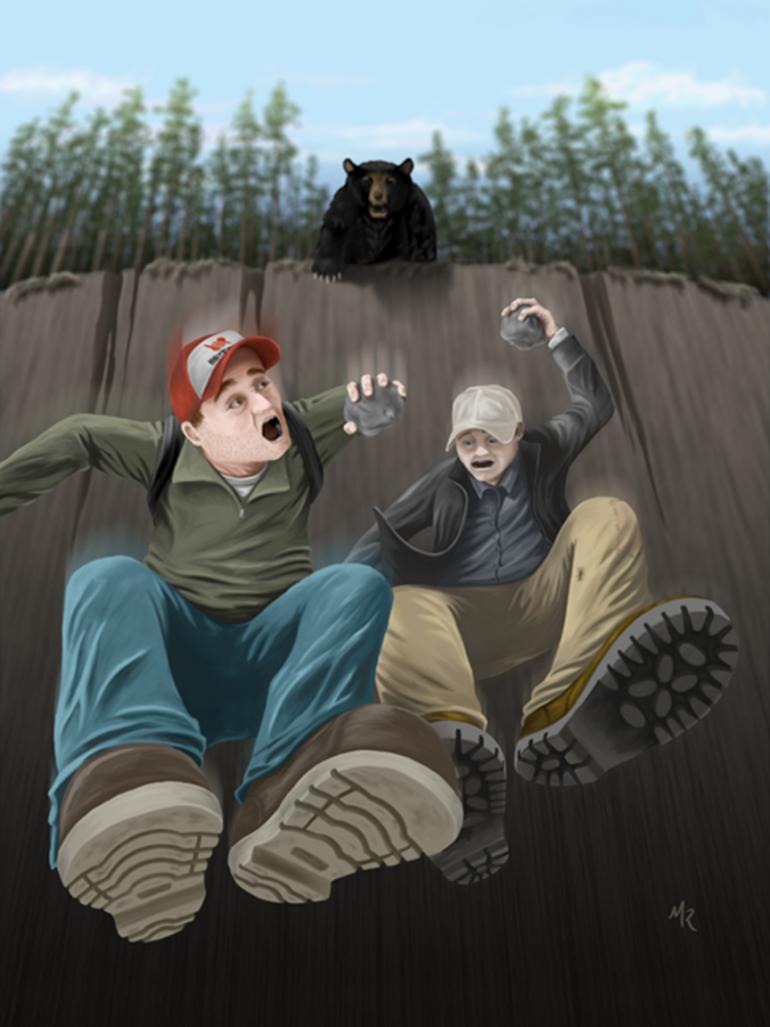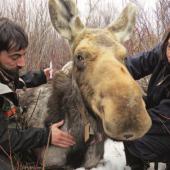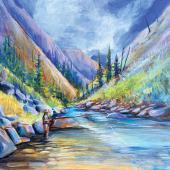Bearly Got Away
There's no bear like your first bear.
No North American critter excites the imagination quite like a bear. Elk are cool, as are eagles, cougars, and moose. But bears establish a psychological foothold practically from birth. Teddy Bear shares our crib; Mom and Dad read to us from Winnie the Pooh; Gentle Ben and Fozzie stare back at us from the TV screen.
It’s been nearly 40 years since I moved to Montana, and I've seen black bears, cinnamon bears, bears in trees, bears demolishing logs, sows with cubs, a bear on the trail headed in my direction, two bears on the trail headed in my direction, and a sow and a cub eating a camper’s dinner while the camper cursed the bears from the cab of his truck. I’ve seen a lot of bears.
Nothing, however, compares to my first bear. That June in the mid-1970s, the snow was still retreating up the mountains when Randy, a non-traditional-aged botany student at MSU, suggested I accompany him on a field trip to the Gallatin National Forest.
Randy’s family owned property in Glacier National Park and he had worked on the park’s trail crews for several years. He seemed like the perfect companion for me—a greenhorn whose wilderness experience was circumscribed by a handful of hikes into the worn-down mountains of Vermont and New Hampshire and a couple of awkward backpacking trips in the Spanish Peaks.
Soon enough we were chugging through timber splashed with sunlight and shadow. At first I was a little nervous with Randy’s insistence that we bushwhack, but as time passed without my being devoured by a grizzly or trampled by a moose, I began to relax. Randy, meanwhile, introduced me to a cast of woodland characters: the prolific glacier lily, scattered pinedrops, and the retiring fairy slipper. With a knowledgeable companion, the muscular aromas of late spring, and a daypack lumpy with apples and cheddar, this was the Western experience I’d imagined back in the grimy eastern city I'd left not so long ago.
Stooping here, kneeling there, caressing various plants with the tenderness of a lover, Randy’s attention strayed to the earth while my eyes darted about like a pair of dragonflies. A little taller and younger than me, Randy wore patched Carhartt pants and a ball-cap so weathered it was practically colorless. East Coast white-collar types don't wear ball-caps, so mine was a shiny new stiff-brimmed piece promoting a rapacious petrochemical company.
As we hiked along a wooded ridge framed by a precipitous drop on our left, I glimpsed movement at the edge of my vision. Forty yards downhill and not far off our flank, what seemed like an awfully large black bear was nosing around the roots of a fallen tree.
I pulled up short and thumped a cautionary arm across Randy’s chest. When he looked at me like, “What's your problem?” I pointed out the bear with my chin.
Perhaps my cautionary arm-thump was excessive. Or maybe Randy was afraid that I was going to run screaming for my life. Either way, he gave me the finger-over-the-lips hush sign, took hold of the back of my belt and tugged me quietly up the ridge in the direction we’d come.
“What we’re going to do,” he said, maintaining his grip on my belt long after the bear was out of sight, “is make a lot of noise. By the time we get back down there he’ll be gone.”
My expression must have conveyed a good deal of doubt because Randy added, "He's as afraid of us as we are of him."
Speaking loudly and inanely, we came stomping back down the ridge, only to find the bear reared on its hind legs, squinting in our direction. Then it dropped to all fours and ran away downhill, its fat butt quivering like a Disney bear might. Eighty yards out, in a patch of sunlight on the far side of a small creek, the bear wheeled to face us.
“Okay,“ Randy said. “Let’s both shout. He’ll run off.”
Together we raised our voices and the bear—as if affronted by our energetic squalling—charged, splashing across the creek and chewing up half the ground between us before coming to a duff-scattering stop.
“Shout again.”
Sphincter clenched and mouth hanging open, I looked to Randy for clarification.
“He’s bluffing.”
We shouted again and the bear charged again, once more covering approximately half the distance between us and morphing from cuddly Disney bruin to ravening behemoth. With the bear 20 yards out and showing no sign of slowing, the analytical part of my mind—the part that catalogues options and attempts to establish order before I run screaming for my life—began flashing back its report in slow motion.
The untenable ground where the bear stood sloped down to the creek. The ground behind us sloped up the wooded ridge. The ground to our right presented an excruciatingly long dash through sun-splotched timber and twisted deadfall, and 15 feet to our left, a cliff pitched into the unknown.
A laser-fast scan of my surroundings revealed no weapon of the bear-discouraging variety, and while my apples and cheddar might provide a distraction, it was unlikely that I could get my pack off and flung away before the bear tore into us. Having read an outdoor magazine or two, I knew that balling up and playing dead was the preferred option, but considering the apples and cheese on my back, I couldn’t make peace with that option.
Just as my analytical mindset began to shut down, Randy yelled, “Shout again!”
We shouted again and the bear charged again. To be sure, there wasn’t a lot of time for instruction, but without so much as a “Run for your life!” my mentor scooped up a rock and jumped off the cliff. The bear seemed big as a semi as I snatched up a rock of my own and followed Randy over the side.
Amazingly, neither one of us sprained an ankle nor broke a leg when we dropped ten feet, crashed, rolled, and bounded off through a jumble of blown-down timber like a pair of demented mule deer. To the best of my knowledge, the bear never made the leap, although it was a long time before I dared to look back. After a while, we tossed our rocks away and slowed to a walk. Eventually we began to laugh—rather hysterically, as I recall.













